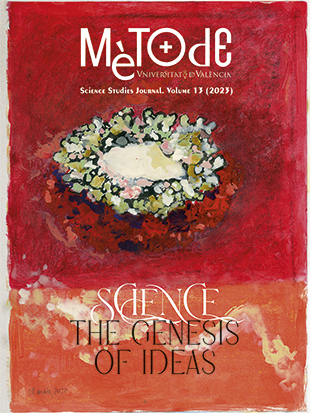Sexo y diseño en nuestros parientes evolutivos: La percepción de la belleza en la naturaleza
DOI:
https://doi.org/10.7203/metode.13.24202Palabras clave:
belleza, neuroestética, fluidez perceptiva, sesgo sensorial, selección sexual Resumen
Resumen
Desde un enfoque evolutivo de la belleza, en este texto analizamos la expresión y la percepción de la belleza sexual en el reino animal. Los cerebros de los animales perciben la belleza y detectan las características del entorno que resultan más relevantes para su supervivencia. A lo largo de la evolución, los animales con reproducción sexual han explotado este proceso de detección para maximizar su atractivo para el sexo opuesto. Habitualmente, esto ha conllevado la aparición de comportamientos y rasgos de cortejo extremos. Estos son rasgos de belleza sexual. Combinando principios neurocientíficos y neuroestéticos modernos con otros provenientes de la biología evolutiva, tratamos de entender las bases biológicas y la evolución de la belleza en todos los animales, incluidos nosotros mismos.
 Descargas
Descargas
 Citas
Citas
Berridge, K. C., & Robinson, T. E. (1998). What is the role of dopamine in reward: Hedonic impact, reward learning, or incentive salience? Brain Research Reviews, 28(3), 309–369. https://doi.org/10.1016/S0165-0173(98)00019-8
Bilger, H. T., Vertosick, E., Vickers, A., Kaczmarek, K., & Prum, R. O. (2021). Higher-order musical temporal structure in bird song. Frontiers in Psychology, 12, 1–11. https://doi.org/10.3389/fpsyg.2021.629456
Changizi, M. A., Zhang, Q., Ye, H., & Shimojo, S. (2006). The structures of letters and symbols throughout human history are selected to match those found in objects in natural scenes. The American Naturalist, 167(5), E117–E139. https://doi.org/10.1086/502806
Cummings, M. E., & Endler, J. A. (2018). 25 years of sensory drive: The evidence and its watery bias. Current Zoology, 64(4), 471–484. https://doi.org/10.1093/cz/zoy043
Dai, X., Brendl, C. M., & Ariely, D. (2010). Wanting, liking, and preference construction. Emotion, 10(3), 324–334. https://doi.org/10.1037/a0017987
Daniel, M. J., Koffinas, L., & Hughes, K. A. (2019). Habituation underpins preference for mates with novel phenotypes in the guppy. Proceedings of the Royal Society B: Biological Sciences, 286, 20190435. https://doi.org/10.1098/rspb.2019.0435
Darwin, C. (1871). The descent of man and selection in relation to sex. John Murray.
Darwin, C. (1872). The expression of emotions in man and animals. John Murray.
Dong, S., & Clayton, D. F. (2009). Habituation in songbirds. Neurobiology of Learning and Memory, 92(2), 183–188. https://doi.org/10.1016/j.nlm.2008.09.009
Dugatkin, L. A., & Godin, J.-G. J. (1992). Reversal of female mate choice by copying in the guppy (Poecilia reticulata). Proceedings of the Royal Society B: Biological Sciences, 249, 179–184. https://doi.org/10.1098/rspb.1992.0101
Hartshorne, C. (1973). Born to sing. Indiana University Press.
Hoke, K. L., Ryan, M. J., & Wilczynski, W. (2010). Sexually dimorphic sensory gating drives behavioral differences in túngara frogs. Journal of Experimental Biology, 213(20), 3463–3472. https://doi.org/10.1242/jeb.043992
Holzleitner, I. J., Lee, A. J., Hahn, A. C., Kandrik, M., Bovet, J., Renoult, J. P., Simmons, D., Garrod, O., DeBruine, L. M., & Jones, B. C. (2019). Comparing theory-driven and data-driven attractiveness models using images of real women’s faces. Journal of Experimental Psychology. Human Perception and Performance, 45(12), 1589–1595. https://doi.org/10.1037/xhp0000685
Houde, A. E. (1997). Sex, color, and mate choice in guppies. Princeton University Press.
Hulse, S. V., Renoult, J. P., & Mendelson, T. C. (2020). Sexual signaling pattern correlates with habitat pattern in visually ornamented fishes. Nature Communications, 11(1), 1–8. https://doi.org/10.1038/s41467-020-16389-0
Lynch, K. S., & Ryan, M. J. (2020). Understanding the role of incentive salience in sexual decision-making. Integrative and Comparative Biology, 60(3), 712–721. https://doi.org/10.1093/icb/icaa054
Maney, D. L. (2013). The incentive salience of courtship vocalizations: Hormone-mediated 'wanting' in the auditory system. Hearing Research, 305(1), 19–30. https://doi.org/10.1016/j.heares.2013.04.011
Prum, R. O. (2017). The evolution of beauty: How Darwin’s forgotten theory of mate choice shapes the animal world-and us. Doubleday.
Renoult, J. P., Bovet, J., & Raymond, M. (2016). Beauty is in the efficient coding of the beholder. Royal Society Open Science, 3(3), 160027. https://doi.org/10.1098/rsos.160027
Renoult, J. P., & Mendelson, T. C. (2019). Processing bias: Extending sensory drive to include efficacy and efficiency in information processing. Proceedings of the Royal Society B: Biological Sciences, 286(1900), 20190165. https://doi.org/10.1098/rspb.2019.0165
Richards, E. (2017). Darwin and the making of sexual selection. University of Chicago Press.
Rosenthal, G. G. (2017). Mate choice: The evolution of sexual decision making from microbes to humans. Princeton University Press.
Rosenthal, G. G., & Ryan, M. J. (2022). Sexual selection and the ascent of women: Mate choice research since Darwin. Science, 375, eabi6308. https://doi.org/10.1126/science.abi6308
Ryan, M. J. (2018). A taste for the beautiful. Princeton University Press.
Sibeaux, A., Cole, G. L., & Endler, J. A. (2019). The relative importance of local and global visual contrast in mate choice. Animal Behaviour, 154, 143–159. https://doi.org/10.1016/j.anbehav.2019.06.020
Street, S. E., Morgan, T. J. H., Thornton, A., Brown, G. R., Laland, K. N., & Cross, C. P. (2018). Human mate-choice copying is domain-general social learning. Scientific Reports, 8(1), 1715. https://doi.org/10.1038/s41598-018-19770-8
Von Uexküll, J. (2014). Umwelt und Innenwelt der Tiere. Springer-Verlag.
Wilczynski, W., Rand, A. S., & Ryan, M. J. (2001). Evolution of calls and auditory tuning in the Physalaemus pustulosus species group. Brain, Behavior and Evolution, 58(3), 137–151. https://doi.org/10.1159/000047268
Descargas
Publicado
Cómo citar
-
Resumen1177
-
PDF 661
-
2
Número
Sección
Licencia
![]()
Todos los documentos incluidos en OJS son de acceso libre y propiedad de sus autores.
Los autores que publican en esta revista están de acuerdo con los siguientes términos:
- Los autores conservan los derechos de autor y garantizan a Metode Science Studies Journal el derecho a la primera publicación del trabajo, licenciado bajo una licencia de Creative Commons Reconocimiento-NoComercial-SinObraDerivada 4.0 Internacional, que permite a otros compartir el trabajo con un reconocimiento de la autoría del trabajo y citando la publicación inicial en esta revista.
- Se permite y se anima a los autores a difundir sus trabajos electrónicamente a través de páginas personales e institucionales (repositorios institucionales, páginas web personales o perfiles a redes profesionales o académicas) una vez publicado el trabajo.





